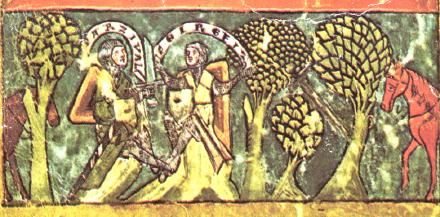Parzival
Written in the first quarter of the thirteenth century, Wolfram von Eschenbach's Parzival offers readers the most elaborate medieval presentation of the Grail legend of the time. Framed as something of a rejoinder to Chrétien de Troyes’s incomplete Perceval, Wolfram’s narrative follows an enigmatic (likely invented) source, Kyot, through whom the reader is granted access to the “heathen” Arabic material essential to the story of the Grail that was absent in Chrétien's tale.
Among Wolfram’s inventions to the narrative is the inclusion of Feirefiz the pagan half-brother to Parzival, an equal in knightly virtue and ability and distinguished primarily by his mottled black and white skin. Feirefiz, who falls in love with the Grail’s maiden, Repanse de Schoye, decides to accept baptism in order to be closer to his love, an act that also allows him to see the Grail. Soon after, Parzival decides to pass the Grail onto Feirefiz, who marries the Grail maiden, returns to the East to preach Christianity, and gives birth to a son, the future keeper of the Grail. That son is Prester John, whose name thereafter becomes the official title of Indian kings. The story of this Prester John is continued in Albrecht von Scharfenberg's sequel/prequel Der jüngere Titurel.

Parzival and Feirefiz (MS Cgm 19, folio 49v, State Library, Munich)
Wolfram writes (pp. 344-45):[Repanse de Schoye] gave birth… in India, to a son, who was called Johan. Prester John they called him; forever they retained that name for the kings there. Feirefiz had letters sent all over the land of India, telling them about the Christian way of life.
In Parzival, Wolfram not only incorporates Prester John into Arthurian lore, he consequently builds John into English history. Prester John becomes a distant descendent of Parzival, himself a distant descendent of Arthur, and yet Wolfram also maintains John’s uncanny, hybrid status in the minds of his readers. As the son of the mottled Feirefiz, Wolfram’s Prester John is himself marked, genealogically and physically, as simultaneously European and Other. Yet while the text integrates John into the Matter of England, Parzival makes no explicit reference to the legend of Prester John. Rather than accrete onto what is already a dense historical tradition, Wolfram connects the two worlds, un-knowing the Prester John legend in order to begin a tradition that might better amplify John’s relevance to Wolfram’s audience.
Brewer sees Parzival as a transition point for the legend (p.22):
Prester John plays a minor role in the story, appearing as a man, the son of the grail maiden Repanse and the half-Saracen Feirefiz, but a man whose name subsequently became the title for a line of kings descended from the original man named Prester John. Although Parzival is a fictional text, this remark represents a conceptual transition in the understanding of 'Prester John.' While earlier writers thought of Prester John as a single man and later writers thought of Prester John as a title, Wolfram von Eschenbach saw him as encapsulating both.